EN 15085 Weld Quality Testing of Station Steel Structures
In the context of railway and transportation infrastructure, ensuring the quality of welded joints is critical to prevent failures that could compromise safety. The European standard EN 15085 addresses this need by providing a framework for non-destructive testing (NDT) methods used in welding processes. This service focuses on the implementation and interpretation of these standards, particularly as they apply to station steel structures.
The primary scope involves ensuring that welds meet the stringent requirements set forth by EN 15085. The standard covers various aspects including pre-weld inspection, welding procedures, and post-weld evaluation. It is designed for use in railway vehicle construction, but its principles are equally applicable to other steel structures within the transportation sector.
The process begins with thorough preparation of the weld joints, which must be free from visible defects such as cracks or porosity before testing can commence. Non-destructive testing methods like ultrasonic testing (UT), radiographic testing (RT), and visual inspection are employed to assess the integrity of the welded joints. These tests not only identify surface-level imperfections but also penetrate deeper into the metal structure, detecting internal flaws that could lead to premature failure.
Once the welds have been tested, detailed reports are generated outlining any issues found during testing and recommendations for corrective actions if necessary. Compliance with EN 15085 ensures that all stakeholders—from manufacturers to end-users—have confidence in the quality of welded components used in railway stations.
| Test Method | Description | Acceptance Criteria |
|---|---|---|
| Visual Inspection (VT) | Inspection using the naked eye or low magnification optics. | No visible defects allowed. |
| Ultrasonic Testing (UT) | Uses sound waves to detect internal flaws without breaking the surface. | Acceptable flaw sizes must not exceed specified limits as per standard. |
| Radiographic Testing (RT) | Uses X-rays or gamma rays to create images of the interior structure. | No defects are allowed within specified zones. |
The use of EN 15085 ensures that railway stations comply with international standards, enhancing safety and reliability. This standard is particularly important in sectors where high levels of precision are required due to the critical nature of the infrastructure.
Why It Matters
The importance of EN 15085 cannot be overstated, especially when considering the long-term operational life and safety implications of railway stations. Welds that do not meet these standards can lead to structural failures during peak usage periods, causing significant disruptions and posing risks to passengers and staff.
The standard's focus on NDT methods ensures that any potential weaknesses in the weld joints are identified early in the manufacturing process. This proactive approach minimizes the need for costly repairs or replacements later on, reducing maintenance downtime and ensuring continuous service availability.
Furthermore, compliance with EN 15085 enhances the reputation of manufacturers by demonstrating their commitment to quality assurance. For buyers and users, this means higher confidence in the integrity and longevity of the steel structures they purchase or utilize.
The railway industry's emphasis on safety and reliability makes adherence to such stringent standards imperative. By implementing EN 15085, stakeholders contribute to a safer environment for all users, thereby upholding the highest standards of professionalism in the sector.
Customer Impact and Satisfaction
The implementation of EN 15085 weld quality testing directly impacts customer satisfaction by ensuring that railway stations are constructed with reliable materials. This process enhances trust between suppliers and buyers, as compliance with international standards is a key factor in selecting reputable partners.
- Enhanced Safety: Non-destructive testing methods help identify potential risks early on, reducing the likelihood of accidents or failures during operation.
- Increased Reliability: By adhering to strict quality control measures, railway stations can maintain their operational efficiency over extended periods without requiring frequent repairs.
- Promotes Professionalism: Compliance with EN 15085 demonstrates a commitment to excellence in the industry, which is highly valued by all stakeholders.
- Cost Efficiency: Early detection of defects through testing can prevent costly repairs and replacements later on, offering significant financial benefits.
In summary, the application of EN 15085 weld quality testing ensures that railway stations are built to last, with minimal risk of failure. This service not only supports the reliability and safety of critical infrastructure but also enhances overall customer satisfaction by providing peace of mind regarding the quality of materials used.
Use Cases and Application Examples
- New Station Construction: During the initial stages of building a new railway station, welds on steel structures are tested to ensure they meet the required standards before proceeding with further construction.
- Maintenance and Repairs: After identifying issues through regular inspections, targeted sections of a station's infrastructure may undergo additional testing to determine if repairs or replacements are necessary.
- Upgrades and Modernizations: As part of modernization projects, existing steel structures at railway stations can be subject to retesting to ensure they meet current safety standards.
| Use Case | Description | Rationale |
|---|---|---|
| New Station Construction | Testing of initial welds to ensure compliance with EN 15085. | To establish a foundation for reliable infrastructure from the outset. |
| Maintenance and Repairs | Targeted testing after identifying potential issues during inspections. | To prevent further deterioration of critical components. |
| Upgrades and Modernizations | Retesting existing structures to ensure they meet current standards. | To maintain safety and reliability in line with modern requirements. |
The application of EN 15085 weld quality testing is crucial for maintaining the integrity and longevity of railway station steel structures. By adhering to these stringent standards, stakeholders can ensure that their infrastructure remains safe, reliable, and compliant with international best practices.





